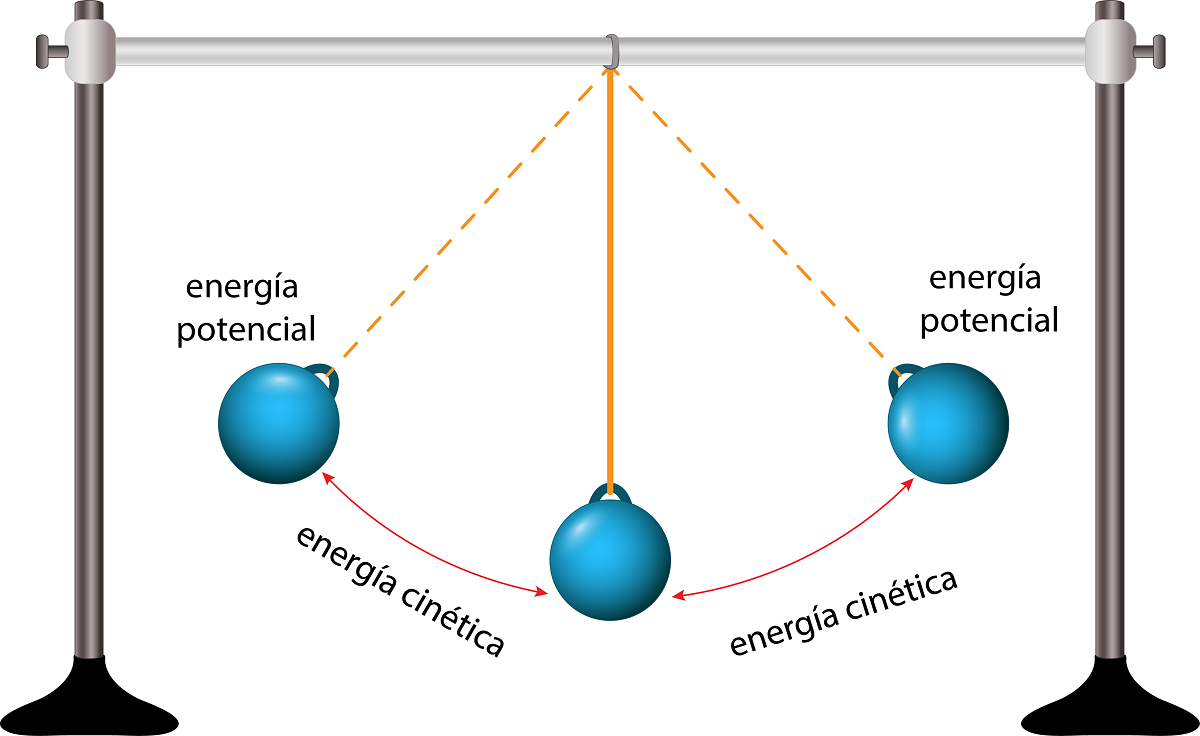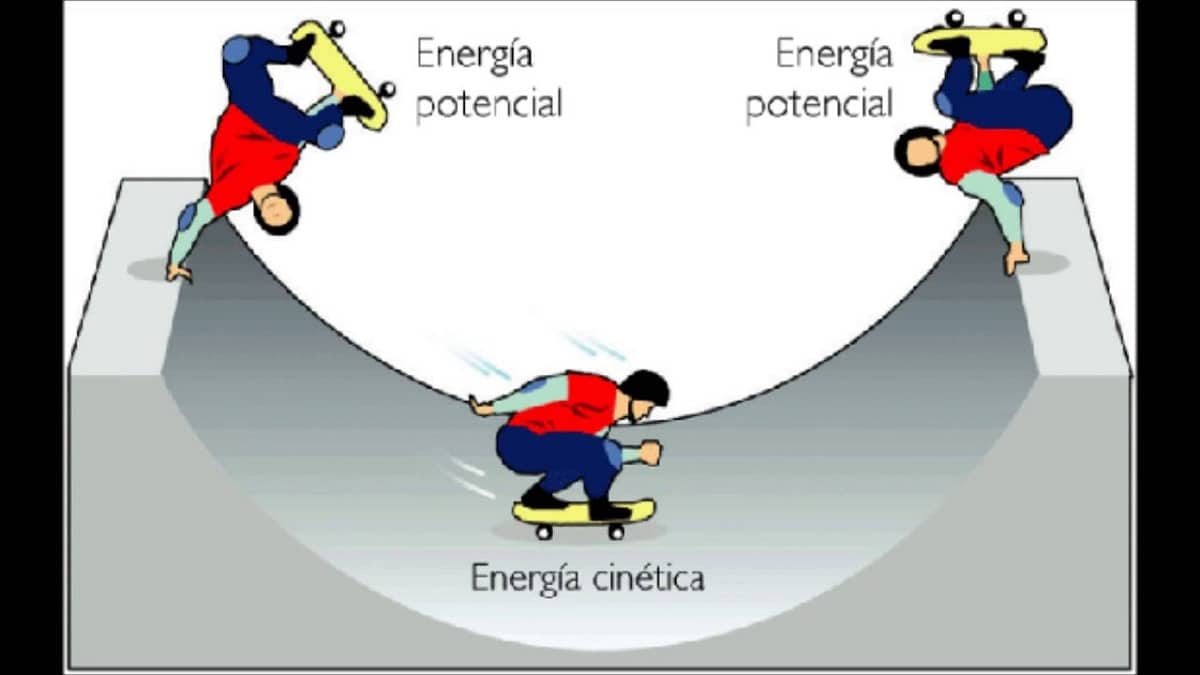
Kinetic energy is the energy related to motion and potential energy is the energy related to position in a system. In general terms, energy is the ability to do work. Both kinetic energy and potential energy represent the two basic types of existing energy. Any other energy is a different version of potential energy or kinetic energy or a combination of both. For example, mechanical energy is a combination of kinetic and potential energy.
In this article we tell you everything you need to know about kinetic and potential energy, its characteristics and examples.
kinetic and potential energy

Kinetic energy
Kinetic energy is the type of energy associated with motion. Everything that moves has kinetic energy. In the International System (SI), the unit of kinetic energy is jouje (J), which is the same unit as work. One joule is equal to 1 kg.m2/s2. There are many examples of the use of kinetic energy in everyday life.
- Bowling: Bowling is a person throwing a 3-7kg ball to knock down 10 pins, which is based on the kinetic energy carried by the ball, which depends on the mass and speed of the ball.
- Wind: Wind is nothing more than air in motion. The kinetic energy of air movement can be converted into electricity using wind turbines.
- Thermal energy: Thermal energy is the kinetic energy associated with the microscopic motion of particles in a system. When we heat water or any other object, we add kinetic energy through heat transfer.
Kinetic energy
Potential energy is the type of energy related to relative position within a system, that is, the position of one object with respect to another. Two separate magnets have potential energy relative to each other. In SI, the unit of potential energy is jouje (J), as is kinetic energy. One joule is equal to 1 kg.m2/s2.
Many of the sources we use for energy depend on potential energy.
- Energy stored in dams: Water stored in an elevated reservoir, such as a dam, has gravitational potential energy. When the water falls, it converts the potential energy into kinetic energy capable of doing work in turbines located at the bottom of the dam. The electricity generated by these turbines is distributed to the local distribution network.
- Springs: When a spring is stretched or compressed, it stores a certain amount of energy in the form of elastic potential energy. When the spring is released, the stored potential energy is converted to kinetic energy.
- Bow and arrow: A bow and arrow are an example of how elastic potential energy is converted into kinetic energy. When the bowstring is stretched, the work done is stored in the stretched string as potential energy. When you loosen the string, the potential energy of the string is converted to kinetic energy, which is then transferred to the arrow.
- Electricity: Electricity is a form of potential energy that is determined by the location of charges in a system (the electric field).
How does kinetic energy work?

When an object is in motion it is because it has kinetic energy. If it collides with another object, can transfer this energy to it, so the second object also moves. For an object to acquire motion or kinetic energy, work or force must be applied to it.
The longer the force is applied, the greater the speed achieved by the moving object and its kinetic energy. Mass is also related to the energy of motion. The greater the mass of the body, the greater the kinetic energy. It can be easily converted into heat or other types of energy.
Among the characteristics of kinetic energy we have:
- It is one of the manifestations of energy.
- It can be transferred from one body to another.
- It can be converted into another type of energy, for example, into thermal energy.
- You have to apply force to initiate movement.
- It depends on the speed and mass of the body.
The sum of kinetic and potential energy produces mechanical energy (energy that relates the position of an object to its motion). As mentioned earlier, dynamics refers to movement. Potential refers to the amount of energy stored in the body at rest.
Therefore, the potential energy will depend on the position of the object or system in relation to the force field that surrounds it. Kinetic energy depends on the motion of an object.
Types of potential energy

gravitational potential energy
Gravitational potential energy is defined as the energy possessed by a massive object when it is immersed in a gravitational field. Gravitational fields are created around very massive objects, like the masses of the planets and the sun.
For example, a roller coaster has the highest potential energy at its highest point due to its immersion in the Earth's gravitational field. Once the car falls and loses height, the potential energy is converted to kinetic energy.
elastic potential energy
Elastic potential energy is related to the elastic properties of a substance, that is, its tendency to return to its original shape after being subjected to a deformation force greater than its resistance. An obvious example of elastic energy is the energy possessed by a spring, which expands or contracts due to an external force and returns to its original position once the external force is no longer applied.
Another example is the bow and arrow system, when the bow is pulled with elastic fibers, the elastic potential energy reaches a maximum, slightly bending the wood, but the speed remains zero. In the next instant, the potential energy is converted to kinetic energy and the arrow shoots out at full speed.
chemical potential energy
Chemical potential energy is the energy stored in the chemical bonds of atoms and molecules. An example is glucose in our body, which stores chemical potential energy that our body converts (through a process called metabolism) into thermal energy to maintain body temperature.
The same goes for fossil fuels (hydrocarbons) in a car's gas tank. The chemical potential energy stored in the chemical bonds of the gasoline is converted into mechanical energy that powers the vehicle.
electrostatic potential energy
In electricity, the concept of potential energy also applies, which can be converted into other forms of energy, such as kinetic, thermal or light, given the enormous versatility of electromagnetism. In this case, the energy comes from the strength of the electric field created by the charged particles.
I hope that with this information you can learn more about kinetic and potential energy.